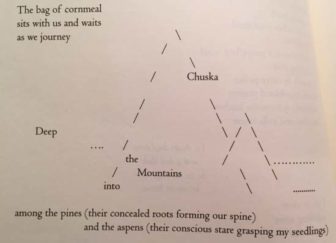Outside her office at the Peaceful Spirit Treatment Center on the Southern Ute Reservation, Navajo poet Esther Belin takes in the thin late-fall sun. Here in the Four Corners of southwestern Colorado, where the Southern Ute, Navajo, Ute Mountain Ute and Jicarilla Apache reservations come together, the landscape is both beautiful and brutal in its spareness, much like Belin’s poems. She’s also an intake counselor at the addiction center, and she lives and works in that world of intersectionality, where language and identity overlap with the triumphs and failures of addiction.
Her new book, Of Cartography, is framed by the four cardinal directions and their symbolism in Navajo history. It digs into the cultural and physical representation of Navajo language, how landscape shapes identity and what it means to be Indian.
Her poems try to capture the rhythm and storytelling intrinsic to the Diné language. “I wanted to investigate whether there was a Navajo meter or diction, and how that voice could come out,” she says. “It’s not just a collection of poems squeezed together. This was about pairing identity politics with Navajo philosophy, which is all very orderly, and then telling my story through the structure.”
That structure shapes the reading experience: Some of the poems are lists, others are questions. Some are wordless grids, X-marked within four quadrants. As a reader, I felt initially uncertain how to read the book, almost queasy. That’s deliberate: Belin wants to show Navajo readers that they don’t have to conform to English standards while giving outsiders a sense of the complicated poetics of tribal storytelling. “It’s for the person who is willing to engage with the pieces,” she says. “Which can be difficult, but that’s kind of the point.”
Belin’s first book, From the Belly of my Beauty, was published in 1999 after the birth of her second daughter. It was a more linear look at being an Indian woman growing up in a white world, stretched between two landscapes: Southern California, where her parents were placed through the federal Indian relocation program, and the Navajo Reservation, where she’s now spent 20 years with her husband and four daughters.
That book, a highly visceral depiction of an off-reservation Indian (Belin says she’s comfortable with that word), challenged the stereotypes of Native identity, rebuking the kind of questions she’s been asked since kindergarten. It won the 2000 American Book Award.

Heather Hansman, from Of Cartography
Esther Belin’s poems are presented in a graphical way.
In the nearly two decades since, she’s taught college and high school writing, finished an MFA program, started counseling and settled into the Southwest. Of Cartography is a sweeping reflection of all that, showing how tribal language can translate feelings and how poetry can help heal the wounds from a history of marginalization.
Belin twists up her long black hair as we talk, revealing big turquoise earrings. Our conversation skips between critical race theory, road trips, her daughter’s college syllabus, and the arcane knot of reservation land-use policy. Her poems braid disparate lines together, too, juxtaposing small-scale details, like evening chores, with the history of Indian relocation policy.
That bundling of ideas draws on Diné language and culture. “The written tradition for us started in boarding school,” she says. “Tribal language is not compartmentalized; it’s about how you’re connected to all these things. Tribal people have a history of trauma from learning that communication form, of reformulating to fit the structure.”
Because of that, she says, she started Of Cartography with form instead of content. She sought to reflect the fluidity of tribal language, in which there’s no single linear way to tell a story. Many of the poems can be read in several directions, and in poems like “Before we Begin,” she plays with line breaks and blank space, to show motion and connection.
She has several other poetic projects in the works, including a biography of Olympic gold medalist Jim Thorpe, a member of the Sac and Fox Nation, which looks at Native masculinity, and a book about the history and federal policies of Navajo land. “The easy piece is doing it through poem. Or at least it is for me,” she says. “That’s my natural voice.”
She’s also working with three other writers on a Diné reader, an anthology of works from 20 Navajo writers, which she sees as a resource for Navajo students and teachers who come to the reservation without a background in tribal scholarship, a way to bridge the gap between state curriculum and Navajo culture.
Belin says she wants Of Cartography to show how structure and language can start to form a tribal canon, and to charge the reader with connecting the dots and understanding the history that shapes Indian life. The last poem, “Assignment 44,” holds that directive: “Analyze the above conversation. Read it aloud. Read it Loudly. Weave / a thread through it.”
Heather Hansman lives in Seattle. She’s currently writing a book about water management and the Green River. Follow @hhansman